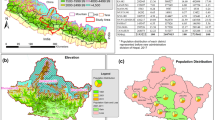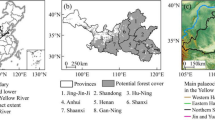Abstract
The objective of this study was to quantify forest cover changes in three watersheds (Gilgel Abbay (1,646 km2), Birr (980 km2), and Upper-Didesa (1,980 km2) of the Blue Nile Basin between 1957 and 2001. Four land cover maps were produced for each watershed for 1957/1958, 1975, 1986, and 2000/2001. Nine different types of land cover were identified, five of which were forest cover classes. Between 1957 and 2001, the total forest cover increased in Gilgel Abbay (from 10 to 22 % cover) and decreased in Birr (from 29 to 22 % cover) as well as in Upper-Didesa (from 89 to 45 % cover). The increase in Gilgel Abbay was primarily due to the expansion of eucalyptus plantations. Natural forest cover decreased in all three watersheds. Wooded grassland decreased by two-thirds, dry/moist mixed forests decreased by half, and riverine forests had disappeared by 1975 in Gilgel Abbay and Birr. Major deforestation had already taken place in the northern watersheds, Gilgel Abbay and Birr, before the 1960s and 1970s, while in the southern watershed, Upper-Didesa, much of the deforestation occurred after 1975. The southern watershed still remained by far the most forested watershed in 2001 despite the strong ongoing deforestation. The changes in forest cover could affect natural resource management, greenhouse gas emissions, water resources, and agricultural production including coffee production. The patterns of change are different in the three watersheds. We therefore recommend further studies of the local conditions and drivers of change as the basis for designing effective policy to halt further loss of natural forest, which offers a wealth of ecosystem services.





Similar content being viewed by others
References
Awulachew SB, Yilma AD, Loulseged M, Loiskandl W, Ayana M, Alamirew T (2007) Water resources and irrigation development in Ethiopia. IWMI Working Paper 123, Colombo, Sri Lanka, pp xi–10
Baldassarre GD, Elshamy M, van Griensven A, Soliman E, Kigobe M, Ndomba P, Mutemi J, Moges S, Xuan Y, Solomatine D, Uhlenbrook S (2011) Future hydrology and climate in the River Nile basin: a review. Hydrol Sci J 56(2):199–211
Bekele M (1992) Forest history of Ethiopia from early times to 1974. MSc thesis, University of Wales, Cardiff, UK
Bekele M (2003) Forest property rights, the role of state and institutional exigency: the Ethiopian experience. PhD dissertation, Swedish University of Agricultural Sciences, Uppsala
Betrie GD, Mohamed YA, van Griensven A, Srinivasan R (2011) Sediment management modeling in the Blue Nile Basin using SWAT model. Hydrol Earth Syst Sci 15:807–818
Bewket W (2002) Land cover dynamics since the 1950s in Chemoga watershed, Blue Nile Basin, Ethiopia. Mt Res Dev 22(3):263–269
Bewket W (2003) Household level tree planting and its implications for environmental management in the Northwestern highlands of Ethiopia: a case study in the Chemoga watershed, Blue Nile Basin. Land Degrad Dev 14:377–388
Bewket W (2011) Farmers’ knowledge of soil erosion and control measures in the northwestern highlands of Ethiopia. Afr Geogr Rev 30(2):53–70
Bezuayehu T, Sterk G (2008) Hydropower-induced land use change in Fincha’a watershed, western Ethiopia: analysis and impacts. Mt Res Dev 2(8):72–80
Bruijnzeel LA (2004) Hydrological functions of tropical forests: not seeing the soil for the trees? Agric Ecosyst Environ 104:185–228
Davidson J (1993) Ecological aspects of eucalyptus plantations. In: Paper presented at regional expert consultation on eucalyptus. FAO Regional Office for Asia and Pacific, Bangkok, Thailand
DeFries RS, Rudel T, Uriarte M, Hansen M (2010) Deforestation driven by urban population growth and agricultural trade in the twenty-first century. Nature Geosci 3. doi:10.1038/NGEO756
Demel T (2002) Forest types. In: Demel T, Tesfaye B (eds) State of forests and forestry research in Ethiopia: indicators and tools for restoration and sustainable management of forests in East Africa. I-Too, Freiburg, Germany, pp 17–41
Darbyshire I, Lamp H, Mohamed U (2003) Forest clearance and regrowth in northern Ethiopia during the last 3,000 years. Holocene 13(4):537–546
Dickinson RE, Henderson-Sellers A (2006) Modelling tropical deforestation: a study of GCM land-surface parameterizations. QJR Meteorol Soc 114:439–462
Ellison D, Futter M, Bishop K (2012) On the forest cover-water yield debate: from demand- to supply-side thinking. Glob Chang Biol 1–15. doi:10.1111/j.1365-2486.2011.02589.x
ERDAS (2010) ERDAS IMAGINE Version 11. ERDAS
ESRI (2009) ArcMap 9.3. ESRI
ESRI (2010) ArcMap 10.0. ESRI
FAO (2000) Global Forest Resources Assessment (2000) FAO Forestry Paper 140. FAO, Rome, pp 1–80
FAO (2010) Global forest resources assessment 2010. FAO Forestry Paper 163, FAO, Rome, pp xiii–xxxi, 217–326
Farley KA, Jobbagy EG, Jackson RB (2005) Effects of afforestation on water yield: a global synthesis with implications for policy. Glob Chang Biol 11:1565–1576. doi:10.1111/j.1365-2486.2005.01011.x
Gebrehiwot SG, Ayele T, Bishop K (2010) Forest cover and stream flow in the headwater of the Blue Nile: complementing observational data analysis with community perception. Ambio 39:284–294
Gebrehiwot SG, Ilstedt U, Gärdenäs AI, Bishop K (2011) Hydrological characterization of watersheds in the Blue Nile Basin, Ethiopia. Hydrol Earth Syst Sci 15:11–20
Gebrehiwot SG (2012) Hydrology and forests in the Blue Nile Basin: what can be learned from half a century of observations and community perception for water management? PhD dissertation, Swedish University of Agricultural Sciences, Uppsala
Getachew W (1989) The consequences of resettlement of in Ethiopia. Afr Affa (Lond) 88:359–374
Hau CY, Liu CH, Chou TY, Yang LS (2008) The efficacy of semi-automatic classification results by using different cloud detection and diminution method. Int Arch Photogramm Remote Sens Spat Inf Sci XXXVII:607–612
Herweg K, Gebre MY (2002) Adaptation or adoption? Integrating different perceptions of soil and water conservation in Ethiopia. In: Flury M, Geiser U (eds) Local environment in a north–south perspective: issues of participation and knowledge management. Vdf Hochschulverlag AG an der ETH Zurich, Zurich, pp 181–190
IPCC (2007) Climate change 2007: synthesis report. In: Pachauri RK, Reisinger A (eds) Fourth assessment of the Intergovernmental Panel on Climate Change (IPCC). IPCC, Geneva, p 104
Jagger P, Pender J (2003) The role of trees for sustainable management of less-favored lands: the case of eucalyptus in Ethiopia. For Policy Econ 5:83–95
Johnson R (1998) The forest cycle and low river flows: a review of UK and international studies. For Ecol Manag 109:1–7
Laurance WF (1999) Reflections on tropical deforestation crisis. Biol Conserv 91:109–117
Malmer A, Murdiyarso D, Bruijnzeel LS, Ilstedt U (2009) Carbon sequestration in tropical forests and water: a critical look at the basis for common used generalization. Global Chang Biol 1–6. doi:10.1111/1365-2486.2009.01984x
Manandhar R, Odeh IOA, Ancev T (2009) Improving the accuracy of land use and land cover classification of landsat data using post-classification enhancement. Remote Sens 1:330–344. doi:10.3390/rs1030330
McDonnell JJ, McGlynn BL, Kendall K, Shanley J, Kendall C (1998) The role of near-stream riparian zones in hydrology of steep upland catchments. Hydrol Water Resour Ecol Headwaters. In: Proceedings of the headwater ‘98 conference, Meran/Merano, Italy, IAHS Publ. no. 248, pp 173–180
Ministry of Water Resources (1998) Abbay River Basin data collection—site investigation survey and analysis. Ministry of Water Resources, Addis Ababa
Pahari K, Murai S (1999) Modeling for prediction of global deforestation based on the growth of human population. ISPRS J Photogramm Remote Sens 54:317–324
Population Census Commission (2008) Summary and statistics report of the 2007 population and housing census. United Nations Population Fund (UNFPA), Addis Ababa
Rahman MM, Sumantyo JTS (2010) Mapping tropical forest cover and deforestation using synthetic aperture radar (SAR) images. Appl Geomat 2:113–121
Rahmato D (2009) The peasant and the state: studies in agrarian change in Ethiopia 1950s–2000s. Addis Ababa University Press, Addis Ababa
Scott DF (1999) Managing riparian zone vegetation to sustain streamflow: results of paired catchment experiments in South Africa. Can J For Res 29:1149–1157
Senbeta F (2006) Biodiversity and ecology of Afromontane rainforests with wild Coffee arabica L. populations in Ethiopia. PhD thesis, Ecology and Development Series No. 38. ZEF, Germany, pp 90–105
Tabachi E, Lamps L, Guilloy H, Planty-Tabacchi AM, Muller E, Decamps H (2000) Impacts of riparian vegetation on hydrological processes. Hydrol Process 14:2959–2976
Wubneh M (1991) Resettlement and villagization. In: Ofcansky TP, Berry L (eds) A country study: Ethiopia. Library of Congress, Federal Research Division, Washington, D.C.
Wullschleger SD, Meinzer FC, Vertessy RA (1998) A review of whole-plant water use studies in trees. Tree Physiol 18:499–512
Yitaferu B (2007) Land degradation and options for sustainable land management in the Lake Tana Basin (LTB), Amhara Region, Ethiopia. PhD dissertation, University of Bern, Bern, pp 65–110
Zeleke G, Hurni H (2001) Implication of land use and land cover dynamics for mountain resource degradation in the northwestern Ethiopia highlands. Mt Res Dev 21:184–191
Zewdu E, Högberg P (2000) Reconstruction of forest site history in Ethiopian highlands based on 13C natural abundance of soils. Ambio 29(2):83–89
Web
Ethiopian Flora Network http://etflora.net/databases/ecosystmes, 19 May 2011
Nile Basin Initiative (NBI) www.nilebasin.org/entro/IDENprojects.htm, 02 Feb 2011
UN-REDD Programme www.un-redd.org/, 05 Sep 2012
Acknowledgments
This research was supported by funds from SIDA (Swedish International Development Agency) and The Swedish Foreign Affairs Office project “Soil and water management in agricultural production”. Image processing and land cover classification for Gilgel Abbay and Birr were done by SEARCHERS Plc., Ethiopia.
Author information
Authors and Affiliations
Corresponding author
Rights and permissions
About this article
Cite this article
Gebrehiwot, S.G., Bewket, W., Gärdenäs, A.I. et al. Forest cover change over four decades in the Blue Nile Basin, Ethiopia: comparison of three watersheds. Reg Environ Change 14, 253–266 (2014). https://doi.org/10.1007/s10113-013-0483-x
Received:
Accepted:
Published:
Issue Date:
DOI: https://doi.org/10.1007/s10113-013-0483-x




